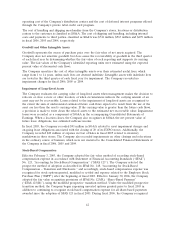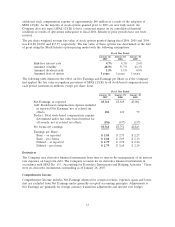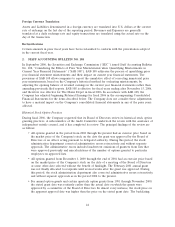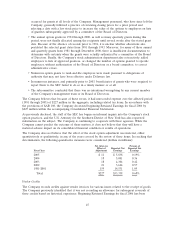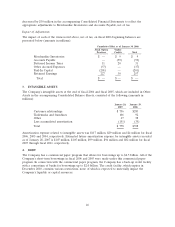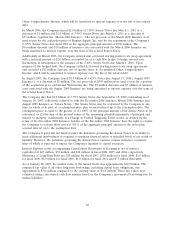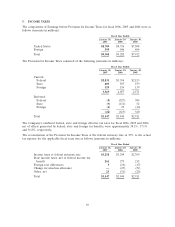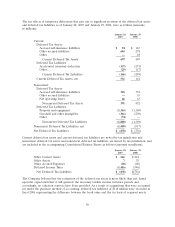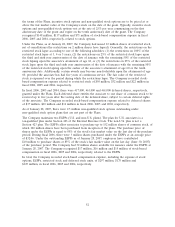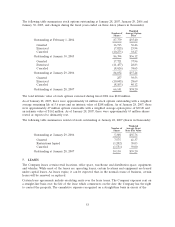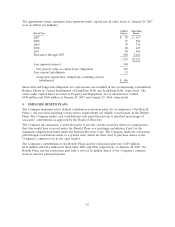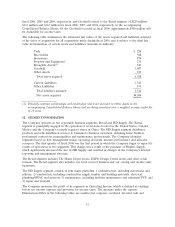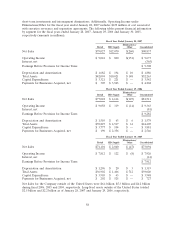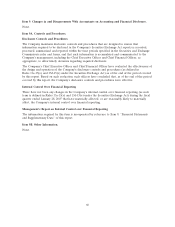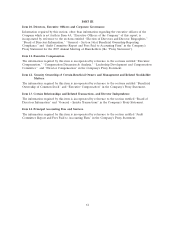Home Depot 2006 Annual Report Download - page 62
Download and view the complete annual report
Please find page 62 of the 2006 Home Depot annual report below. You can navigate through the pages in the report by either clicking on the pages listed below, or by using the keyword search tool below to find specific information within the annual report.the terms of the Plans, incentive stock options and non-qualified stock options are to be priced at or
above the fair market value of the Company’s stock on the date of the grant. Typically, incentive stock
options and non-qualified stock options vest at the rate of 25% per year commencing on the first
anniversary date of the grant and expire on the tenth anniversary date of the grant. The Company
recognized $148 million, $117 million and $71 million of stock-based compensation expense in fiscal
2006, 2005 and 2004, respectively, related to stock options.
Under the Plans, as of January 28, 2007, the Company had issued 12 million shares of restricted stock,
net of cancellations (the restrictions on 2 million shares have lapsed). Generally, the restrictions on the
restricted stock lapse according to one of the following schedules: (1) the restrictions on 100% of the
restricted stock lapse at 3, 4 or 5 years, (2) the restrictions on 25% of the restricted stock lapse upon
the third and sixth year anniversaries of the date of issuance with the remaining 50% of the restricted
stock lapsing upon the associate’s attainment of age 62, or (3) the restrictions on 25% of the restricted
stock lapse upon the third and sixth year anniversaries of the date of issuance with the remaining 50%
of the restricted stock lapsing upon the earlier of the associate’s attainment of age 60 or the tenth
anniversary date. Additionally, certain awards may become non-forfeitable upon the attainment of age
60, provided the associate has had five years of continuous service. The fair value of the restricted
stock is expensed over the period during which the restrictions lapse. The Company recorded stock-
based compensation expense related to restricted stock of $95 million, $32 million and $22 million in
fiscal 2006, 2005 and 2004, respectively.
In fiscal 2006, 2005 and 2004, there were 417,000, 461,000 and 461,000 deferred shares, respectively,
granted under the Plans. Each deferred share entitles the associate to one share of common stock to be
received up to five years after the vesting date of the deferred share, subject to certain deferral rights
of the associate. The Company recorded stock-based compensation expense related to deferred shares
of $37 million, $10 million and $14 million in fiscal 2006, 2005 and 2004, respectively.
As of January 28, 2007, there were 2.5 million non-qualified stock options outstanding under
non-qualified stock option plans that are not part of the Plans.
The Company maintains two ESPPs (U.S. and non-U.S. plans). The plan for U.S. associates is a
tax-qualified plan under Section 423 of the Internal Revenue Code. The non-U.S. plan is not a
Section 423 plan. The ESPPs allow associates to purchase up to 152 million shares of common stock, of
which 120 million shares have been purchased from inception of the plans. The purchase price of
shares under the ESPPs is equal to 85% of the stock’s fair market value on the last day of the purchase
period. During fiscal 2006, there were 3 million shares purchased under the ESPPs at an average price
of $32.06. Under the outstanding ESPPs as of January 28, 2007, employees have contributed
$10 million to purchase shares at 85% of the stock’s fair market value on the last day (June 30, 2007)
of the purchase period. The Company had 32 million shares available for issuance under the ESPPs at
January 28, 2007. The Company recognized $17 million, $16 million and $15 million of stock-based
compensation in fiscal 2006, 2005 and 2004, respectively, related to the ESPPs.
In total, the Company recorded stock-based compensation expense, including the expense of stock
options, ESPPs, restricted stock and deferred stock units, of $297 million, $175 million and
$125 million, in fiscal 2006, 2005 and 2004, respectively.
52


